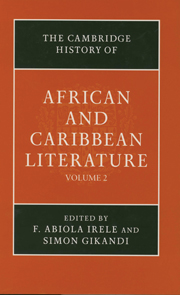Book contents
- Frontmatter
- 23 East African literature in English
- 24 Anglophone literature of Central Africa
- 25 West African literature in English: beginnings to the mid-seventies
- 26 South African literature in English
- 27 African literature in French: sub-Saharan Africa during the colonial period
- 28 North African literature in French
- 29 Francophone literatures of the Indian Ocean
- 30 African literature in Spanish
- 31 African literature in Portuguese
- 32 Popular literature in Africa
- 33 Caribbean literature in French: origins and development
- 34 Caribbean literature in Spanish
- 35 Anglophone Caribbean literature
- 36 The Harlem Renaissance and the Negritude movement
- 37 Postcolonial Caribbean identities
- 38 African literature and post-independence disillusionment
- 39 “Postcolonial” African and Caribbean literature
- 40 Modernism and Postmodernism in African literature
- Index
- References
30 - African literature in Spanish
Published online by Cambridge University Press: 28 March 2008
- Frontmatter
- 23 East African literature in English
- 24 Anglophone literature of Central Africa
- 25 West African literature in English: beginnings to the mid-seventies
- 26 South African literature in English
- 27 African literature in French: sub-Saharan Africa during the colonial period
- 28 North African literature in French
- 29 Francophone literatures of the Indian Ocean
- 30 African literature in Spanish
- 31 African literature in Portuguese
- 32 Popular literature in Africa
- 33 Caribbean literature in French: origins and development
- 34 Caribbean literature in Spanish
- 35 Anglophone Caribbean literature
- 36 The Harlem Renaissance and the Negritude movement
- 37 Postcolonial Caribbean identities
- 38 African literature and post-independence disillusionment
- 39 “Postcolonial” African and Caribbean literature
- 40 Modernism and Postmodernism in African literature
- Index
- References
Summary
African literature in Spanish is a cultural project that has received very little critical and theoretical attention, compared to francophone, anglophone, or lusophone African literature. Beyond certain limited circles in Madrid and Euskadi (Basque territory) in Spain, African literature in Spanish may be considered the most conspicuous absentee in the literary debate on Hispanic and/or African literatures. On that basis, Guinean poet Ciriaco Bokesa Napo observed:
Pero lo Español, en tierras africanas y de plumas estrictamente africanas, queda en la memoria de una cita apenas esbozada.
But the Spanish language in African lands, issuing from strictly African pens, lives on only as a trace.
(1989: 11)This chapter proposes to explore the circumstances of the gestation, birth, and development of African literature written in Spanish between 1947 and the 1990s. It will examine the sociohistorical trajectory and the diverse forms of literary expression specifically in the cultural project of Equatorial Guinea. The former “Spanish Territories of the Gulf of Guinea,” which subsequently became “Spanish Guinea,” were a Spanish possession for almost two centuries. The sole Spanish colony in sub-Saharan Africa, Equatorial Guinea is thus the only African country south of the Sahara whose official language is Spanish and therefore producing a literature written in the language of Cervantes. As a production at the junction of two different literary experiences – the first, Bantu and black African, marked by the stamp of orality with its pragmatic and supple rules, and the other, European, characterized by the more rigid rules of writing – the writing of Equatorial Guinea, like most texts of African literature written in foreign, European tongues, inherited this double cultural tradition that endows it with a very specific character.
- Type
- Chapter
- Information
- The Cambridge History of African and Caribbean Literature , pp. 584 - 602Publisher: Cambridge University PressPrint publication year: 2000

